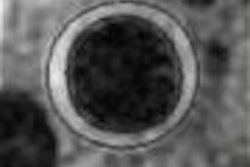Three-dimensional volume ultrasound offers a much quicker examination of the second-trimester fetus than traditional 2D ultrasound, according to an article in the March issue of the Journal of Ultrasound in Medicine.
"Using 3D volume acquisition, it is feasible to perform and interpret a structural survey in half the time in which a 2D survey is performed," according to a research team from Brigham & Women's Hospital and Massachusetts General Hospital in Boston (JUM, March 2005, Vol. 24:3, pp. 371-378).
The researchers performed a pilot study, examining 25 consecutive second-trimester fetuses with standard 2D ultrasound and 3D volume ultrasound using a Voluson 730 scanner with a 4- to 7-MHz 3D volume transducer (GE Healthcare, Chalfont St. Giles, U.K.). Normal structural surveys were performed on 2D, followed immediately by five standard 3D volume acquisitions in the regions of the head, chest, abdomen, face, and lower extremities.
The 2D and 3D images were then compared to judge the completeness of the fetal survey, measurements of the biparietal diameter and femur length, and time required to perform the fetal survey.
In 20 of the 25 cases using 3D reconstructed volumes, the structural surveys were complete. The researchers found that one fetus had an incomplete evaluation of the face on 3D volumes, and on 2D it was limited because of the prone position of the fetus. The other four fetuses with incomplete surveys done on 3D volumes had missing images of a hand or foot.
Three-dimensional reconstructions slightly overmeasured the biparietal diameter compared with the 2D reference standard, with a mean difference of 1.1 mm (p < 0.001). That mean difference was not statistically significant for femur length, according to the researchers.
Complete surveys by the 3D-volume method took a mean time of 1.1 minutes to obtain the 3D volumes and 5.5 minutes to reconstruct the complete surveys. In contrast, the standard 2D techniques required a mean time of 13.9 minutes to complete the structural surveys, for a mean difference between methods of 7.3 minutes (p = 2.4 x 10-9).
"Our pilot study shows not only that it is feasible to perform a near-complete structural survey as per accepted AIUM (American Institute of Ultrasound in Medicine) guidelines, but also that this can be done in half the time in which efficient 2D surveys are being performed today, with an average of one-minute scan time per patient in the sonography room," the authors wrote. "This level of efficiency has been enjoyed for years by other cross-sectional modalities such as CT, but only now has sonography developed the capabilities to implement similar volume acquisitions."
The researchers plan additional research, including a comprehensive study involving all the sonographers and physicians at Brigham & Women's Hospital and Massachusetts General Hospital, as well as a multicenter trial designed to evaluate the feasibility and time-saving of 3D sonography as a vehicle for performing anatomic fetal surveys at remote locations.
"We need to move sonography into a modern era of volume scanning with all the attendant flexibility and additional benefits," the study team stated. "These new techniques will hopefully reaffirm sonography's role in cross-sectional imaging, and will play an important role in obstetric and gynecologic imaging for the future."
By Erik L. Ridley
AuntMinnie.com staff writer
March 17, 2005
Related Reading
3D ultrasound poised to revolutionize pelvic imaging, September 9, 2004
3D and the future of imaging, November 3, 2003
3D ultrasound offers reliable assessment of gallbladder, bile ducts, May 5, 2003
3D ultrasound requires understanding of artifacts, July 8, 2002
3D ultrasound excels at detecting ovarian cancer, March 14, 2001
Copyright © 2005 AuntMinnie.com




















